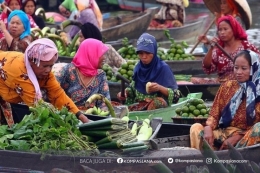The total population of Indonesia is 266,794,980 people. The people of Indonesia speak the Indonesian language. The linguistic diversity of Indonesia is very diverse according to a fractionation scale, which is 0.768 for Indonesia. The average age is around 29.2 years. Life expectancy in Indonesia is 71. The female fertility rate in Indonesia is 2.6. About 5% of Indonesia's population are obese. Ethnic diversity is quite diverse according to a fractionation scale that is 0.7351 for Indonesia. For details on the language, religion, age, gender distribution and progression of the people of Indonesia, read the sections below and visit the section on education in the country.
Population
In Indonesia, the population density is 135 people per square kilometer (351 per square mile). Based on these statistics, this country is considered to be densely populated. The total population of Indonesia is 266,794,980 people. Indonesia has approximately 295,433 foreign immigrants. Immigrants in Indonesia make up 0.2 percent of the total number of immigrants worldwide. Immigrants in Indonesia make up 0.1 percent of the total number of immigrants worldwide. The ethnic diversity of Indonesia is quite diverse according to a factioning scale based on ethnicity. Ethnic fractionation (EF) deals with the number, size, socio-economic distribution, and geographic location of various cultural groups, usually in a state or otherwise demarcated territory. Specific cultural characteristics, alone or in combination, can relate to language, skin color, religion, ethnicity, customs and traditions, history or other characteristic criteria. These characteristics are often used for social exclusion and monopoly of power. The ethnic fractionation index in Indonesia is 0.7351. This means that there are a relatively high number of unique ethnic groups in Indonesia. EF is usually measured as 1 minus the Herfindahl concentration index of ethno-linguistic group proportions, which reproduces the probability that two randomly drawn individuals from the population belong to different groups. The theoretical maximum of EF of 1 means that each person belongs to a different group. Below you will find statistics for Indonesia on the median age and the gender distribution at different age groups.
Age
The average age is around 29.2 years. The average age for men is 28.7 while the average age for women is 29.8.
Gender
The gender ratio or the number of men for each woman (estimated at birth) is 1.05. It can be further subdivided into the following categories: gender ratio below 15 - 1.03; Gender ratio from 15 to 64 - 1.01; Gender ratio over 64 - 0.8; Overall Gender Ratio - 1. The overall gender ratio is different from the gender ratio estimated at birth. This is because some newborns are included in the gender ratio estimated at birth, but die within the first few weeks of life and are not included in the overall gender ratio.
Religion
The majority religion in Indonesia is Islam, whose followers make up 87.2% of all believers in the country. Islam (Arabic: الإسلام) is a monotheistic and Abrahamic religion that is articulated through the Koran, a religious text used by its followers as the literal Word of God (Allah) and for the vast majority of followers through the teachings and normative the example (called Sunna, Arabic سنة, composed of Hadith, Arabic حديث) of Mohammed, who is considered by most to be the last prophet of God, is considered. A follower of Islam is called a Muslim. In addition to Islam, there are several other religions in the country. Other religions in Indonesia are Islam, Hinduism. Indonesia's religious diversity is vaguely diverse on a fractionation scale based on the number of religions in Indonesia. The religious fractionation index in Indonesia is 0.234. This score means that there is one major belief within the country with a few other minor beliefs.
General development
Indonesia is considered a developing country. A nation's stage of development is determined by a number of factors, including economic prosperity, life expectancy, income equality, and quality of life. As a developing country, Indonesia may not be able to provide consistent social services to its citizens. These social services can include things like public education, reliable health care, and law enforcement. Developing country citizens may have a lower life expectancy than developed country citizens. In Indonesia, 15.36 out of 100 people use the Internet. Indonesia has a Human Development Index (HDI) of 0.684. Indonesia has an upper middle HDI value. This suggests that the majority of citizens will be able to live desirable lives, although some citizens will not be able to achieve a high standard of living. The migration rate in Indonesia is -1.16%. In Indonesia, 11% of the population live below the poverty line. The proportion of citizens living below the poverty line in Indonesia is low, which suggests a stable economy. Investors should view Indonesia as a safe place for investment and other financial companies.
Language
The people of Indonesia speak the Indonesian language. Indonesia's linguistic diversity is very diverse on a fractionation scale based on the number of unrelated languages spoken in Indonesia. The Indonesian Linguistic Fractionation Index is 0.768. This means that several major languages coexist within Indonesia. There are several additional minor languages. Unrelated languages share few features of grammatical structure, vocabulary, and etymological heritage in common. Linguistic diversity often creates social and cultural fractionation problems that can affect a country's political circumstances and public policies.
Follow Instagram @kompasianacom juga Tiktok @kompasiana biar nggak ketinggalan event seru komunitas dan tips dapat cuan dari Kompasiana. Baca juga cerita inspiratif langsung dari smartphone kamu dengan bergabung di WhatsApp Channel Kompasiana di SINI







